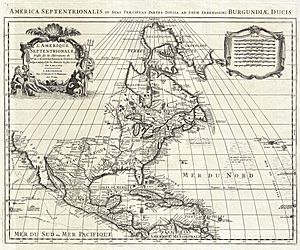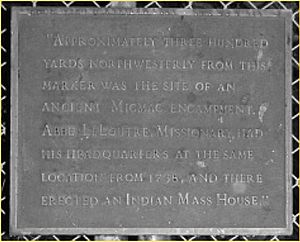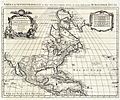Jean-Louis Le Loutre facts for kids
Quick facts for kids
Jean-Louis Le Loutre
|
|
|---|---|

Vicar general Le Loutre
|
|
| Born | September 26, 1709 Morlaix, France |
| Died | September 30, 1772 (age 63) Nantes, France |
| Allegiance | |
| Service/ |
French missionary |
| Rank | Vicar General of Acadia |
| Battles/wars | King George's War |
| Signature | |
Abbé Jean-Louis Le Loutre (born September 26, 1709 – died September 30, 1772) was a Catholic priest and missionary. He played a big role in the fight between the French and the British in Acadia. This area is now Nova Scotia and New Brunswick in Canada.
Le Loutre became a leader for the French, the Acadians, and the Miꞌkmaq people. He helped them during two important conflicts: King George's War and Father Le Loutre's War. These wars were about who would control Acadia in the 1700s.
Contents
Acadia: A Disputed Land

After the Treaty of Utrecht in 1713, Nova Scotia was under British rule. Most British people lived in the capital, Annapolis Royal. However, the Acadians and the native Mi'kmaq people lived throughout the rest of the region.
Île-Royale (now Cape Breton Island) stayed under French control. But the mainland part of Acadia (today's Nova Scotia and New Brunswick) was British territory. The French still wanted to control it.
By 1738, France had no official army in mainland Nova Scotia. The Acadians had refused to promise loyalty to the British king. They could not help France take back Nova Scotia without French military support.
Early Life and Mission
Jean-Louis Le Loutre was born in 1709 in Morlaix, France. His parents were a paper maker and his wife. In 1730, he began studying to become a priest in Paris.
After his training, he joined the Seminary of Foreign Missions in 1737. He wanted to serve the church in other countries. Le Loutre was sent to eastern Canada to work with the Mi'kmaq people. He arrived in Nova Scotia in 1738.
Learning the Mi'kmaq Language
Le Loutre first went to Louisbourg, Île-Royale. He spent about a year learning the Miꞌkmaq language from another missionary, Pierre Maillard.
Then, Le Loutre was sent to the Mission Sainte-Anne in Shubenacadie. His work also included French settlements at Cobequid and Tatamagouche. At first, his relationship with the British leaders was friendly.
King George's War
Great Britain had taken control of Acadia in 1710. France formally gave Acadia to Britain in the 1713 Treaty of Utrecht. But there were disagreements about the exact borders. Some Acadians also did not want to be ruled by the British.
When war started again in 1744, France planned to take back Nova Scotia. They wanted to attack the capital, which the British had renamed Annapolis Royal.
Attacks on Annapolis Royal
During King George's War, Le Loutre and the Acadians were caught in the middle. Many British officials believed Le Loutre and the Acadians supported the French. Le Loutre might have been involved in two attacks on the British at Annapolis Royal.
The first attack on Fort Anne happened in July 1744. It ended quickly because French ships did not arrive to help. A second attack in September also failed. The French did not have the right cannons to break through the fort's defenses.
After these attacks, the British governor in Massachusetts offered rewards for Mi'kmaq scalps and prisoners. The Mi'kmaq withdrew, and the French forces had to retreat.
The next year, Louisbourg was captured by New England soldiers. Le Loutre went to Québec to talk with French leaders. They made him the main contact with the Mi'kmaq, who were already fighting the British. This allowed the French government to work with the Mi'kmaq fighters in Acadia.
The Duc d'Anville Expedition
Another attempt to take Annapolis Royal was planned in 1746. This was the Duc d'Anville expedition. Le Loutre became the link between the Acadian settlers and the French forces.
He was supposed to meet the French fleet at Baie de Chibouctou (now Halifax Harbour). Le Loutre was one of the few people who knew the secret signals to identify the French ships. He also had to help the French navy work with the army that was sent to recapture Acadia.
The French army arrived in July, but only a few French ships had reached the harbor. Le Loutre suggested attacking Annapolis Royal without the full fleet. But his advice was not followed. They waited for over two months, but the expedition was delayed by bad weather and disease. It eventually returned home without attacking.
After this failed mission, Le Loutre went back to France. He tried twice to return to Acadia during the war but was captured and imprisoned by the English both times. In 1749, after the war ended, he finally returned.
Father Le Loutre's War
Le Loutre moved his main base in 1749 to Pointe-à-Beauséjour. This area is on the Isthmus of Chignecto, where France and England were arguing over who owned present-day New Brunswick.
A year after the British built Halifax in 1749, they built forts in major Acadian towns. These included Fort Edward and Fort Vieux Logis. They wanted to control the local people.
Le Loutre encouraged the Mi'kmaq to keep fighting the British. He wanted it to look like the Mi'kmaq were acting on their own. This way, France would not seem to be directly involved in the fighting.
Since France and Britain were officially at peace, Le Loutre led a guerrilla fight. He resisted the British building forts in Acadian villages. The French army could not openly fight the British.
Le Loutre and the French were at Beauséjour, across from Beaubassin. In early 1750, the British tried to take control of these areas. Le Loutre, the Mi'kmaq, and Acadians fought them off. On April 23, Le Loutre burned the village of Beaubassin. This stopped the British from using its supplies to build a fort.
The British then built Fort Edward at Piziquid. They made the Acadians destroy their church to build the fort. Later, the British returned to Beaubassin to build Fort Lawrence. Le Loutre and the Acadians continued to resist, but the British eventually built their fort.
In 1751, the French built Fort Beauséjour. Le Loutre saved a bell from the Beaubassin church and placed it in the new cathedral next to Fort Beauséjour.
Raid on Dartmouth
On September 30, 1749, Mi'kmaq fighters attacked a sawmill near present-day Dartmouth, Nova Scotia. They killed four workers. In response, the British governor offered a reward for capturing or scalping Mi'kmaq men. He also offered rewards for capturing Mi'kmaq women and children.
The Acadian Exodus
As the British took more control of Nova Scotia, Le Loutre led Acadians from the Cobequid region to New Brunswick and Prince Edward Island. The British wanted the Acadians to stay because they were good farmers.
However, the Acadians asked to be allowed to refuse to fight against other French people. If not, they would leave. The British governor refused. He warned them that if they left, they could not take their belongings. He also said that the area north of the Missaguash River was still British territory.
Despite these threats, most Acadians from Cobequid followed Le Loutre. He tried to set up new communities. But it was hard to get enough food and supplies for the new settlers, the Mi'kmaq, and the forts.
In 1752, Le Loutre asked leaders in Quebec for help. He then went to France to get money. In 1753, he received funds to build dykes in Acadia. These dykes would protect low-lying lands from tides, making them good for farming and raising cattle. This would help the Acadians avoid starvation. Le Loutre returned to Acadia with more missionaries in 1753.
Battle of Fort Beauséjour
In 1754, Le Loutre was made the main church leader for Acadia. He kept encouraging the Mi'kmaq to bother the British. He also had Acadians help build a large cathedral at Beauséjour. It was a copy of the Notre-Dame de Québec Cathedral.
A month after the cathedral was finished, the British attacked. As Fort Beauséjour was about to fall, Le Loutre burned the cathedral. He did this to stop the British from getting it. He saved the bell, which was very valuable and a symbol of hope. This defeat led to the Deportation of the Acadians. The saved bell is now at the Fort Beauséjour National Historic Site.
Imprisonment and Legacy
Le Loutre escaped through the woods to Quebec. Later, he sailed for France from Louisbourg. But in September 1755, his ship was captured by the British. Le Loutre was taken prisoner.
He was held in Elizabeth Castle on Jersey island for eight years. He was released after the Treaty of Paris (1763) was signed, ending the Seven Years' War.
After his release, he tried to help Acadians who had been sent to France. He helped them settle in areas like Morlaix and Poitou. Le Loutre died in Nantes, France, on September 30, 1772. He was on a trip to show Acadians land in Poitou. He left all his belongings to the displaced Acadians.
Historians have called Le Loutre "the soul of the Acadian resistance." A street in Gatineau, Quebec, is named after him.
Images for kids










